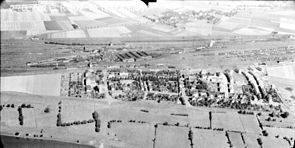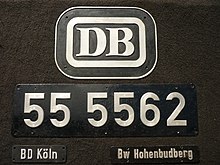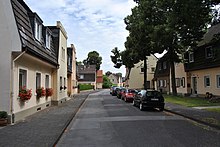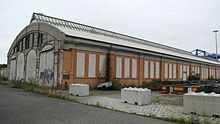Hohenbudberg train station
| Hohenbudberg | |
|---|---|
|
Station and railway settlement in 1953
|
|
| Data | |
| Design | Two-sided marshalling yard |
| abbreviation | KH KHS (Hohenbudberg settlement) |
| opening | 1906 |
| Conveyance | September 26, 1986 |
| location | |
| City / municipality | Duisburg |
| Place / district | Friemersheim |
| country | North Rhine-Westphalia |
| Country | Germany |
| Coordinates | 51 ° 22 '52 " N , 6 ° 40' 48" E |
| Railway lines | |
| Railway stations in North Rhine-Westphalia | |
The Hohenbudberg station in Duisburg was a 1906 Gone in operation and of abandoned since 1986 the marshalling yard ; In its heyday it was one of the largest marshalling yards in Germany.
location
Since the municipal reorganization in 1975, the former station area has been entirely located in Duisburg's urban area (left bank of the Rhine in the Rheinhausen district, Friemersheim district ) on the city limits of Krefeld , Uerdingen district, Hohenbudberg district .
Since the 19th century the eponymous for the station village belonged Hohenbudberg-Kaldenhausen for mayor Friemersheim (1923 mayoralty Rheinhausen). In 1927, the southern part of the municipality, with the Hohenbudberg district, was reunited to Uerdingen in what was then the Krefeld district. The rest of the community Hohenbudberg-Kaldenhausen remained as community Kaldenhausen in the mayor's office Rheinhausen.
The station tracks ran from southwest to northeast, the western part (bordering Krefeld) with an area of 17 hectares lay within the municipality (Hohenbudberg) -Kaldenhausen (from 1934 Rumeln-Kaldenhausen ), the eastern part with an area of 8.919 hectares in the Friemersheim community. In the latter is the railway settlement built from 1912 including the Hohenbudberg water tower .
construction
The station was on the VzG route 2504 (Krefeld-Lohbruch - Rheinhausen ). The freight line ran parallel to the VzG line 2505 ( Krefeld-Oppum - Bochum Nord), which leads past the station to the north. Between the two lines, the VzG line 2342 ( Krefeld-Uerdingen - Duisburg-Mühlenberg - Hohenbudberg) also ran along the northern edge of the marshalling yard, and ended in the transformer group on the northern edge of the station. At the east head the VzG route 2340 (Duisburg-Mühlenberg - Hohenbudberg - Trompet ) and the VzG route 2333 ( Oberhausen West - Duisburg-Baerl - Hohenbudberg) threaded out. In addition to the VzG line 2505, the VzG lines 2342 and 2340 have been preserved. The routes are linked to one another at the Duisburg-Mühlenberg junction.
The marshalling yard had a total of three shunting systems, the southern group was intended for trains in the direction of the Ruhr area , the northern and middle group for trains in the opposite direction. The north and middle group comprised a total of 16 entry tracks (Gl 1o – 6o and 7o – 16o) and 56 direction tracks (Gl 19w – 40w and 41w – 76w). The southern group comprised nine entry tracks (Gl 81–89) and 28 direction tracks (Gl 26o – 53o). There was no separate exit group for any of the systems. There was also a transformer group north of the north mountain, several traffic tracks within the shunting systems and through tracks on the north and south edges of the station. The Hohenbudberg Siedlung stop was located at the level of the Südberg to connect the Friemersheim railroad settlement.
The area between the north and middle mountains was taken up by a wagon hall, in which, among other things, wagons were loaded after they had run down. The Hohenbudberg depot was located between the Mittelberg and Südberg . The centerpiece of the facility was a rectangular shed with ten tracks, with two 23-meter turntables connected to both ends . To the west of the shed was the coal barn. Further operational facilities completed the Bw.
For shunting operations, the station was divided into a total of seven shunting districts. In addition, there were nine mechanical and electromechanical interlockings to ensure operations. Command signal boxes with a dispatcher were located at the west head (Hwf), at the south mountain (Hsf) and at the east head (courtyard). Signalman interlockings were at the Umspanngruppe (Hm), the West head at the level of Northern group (R1), at the Nordberg (R4), means Berg (R5) and to the access roads to the Bw (R3 and R7). The Mühlenberg branch near the train station had its own signal box (Abzw). It is the only remaining system besides the signal box in Hof.
history
Use by the railway began on December 20, 1896 with the commissioning of the installation station in the municipalities of Budberg and Friemersheim , and from 1902 it was referred to as the Vorbahnhof Uerdingen . It developed into the most important marshalling yard on the left bank of the Rhine and was expanded to a total of 26,343 hectares between 1901 and 1902 and finally renamed Hohenbudberg . It was the central freight train formation facility of the left Lower Rhine , a double-track main line provided a connection to the Oberhausen junction .
The station expanded to its greatest extent by 1928. The length of the station area at that time was 3.2 kilometers, at its widest point there were up to 73 tracks next to each other, where hundreds of trains with thousands of cars were put together every day. In the mid-1950s, the station had 145 kilometers of track systems and 425 points (up to 700 in the 20s / 30s). In 1955 58,100 trains with 1,266,400 wagons were handled, i.e. around 160 trains a day. 80 steam locomotives were available for the shunting service . At peak times, 200 to 300 trains with 3,500 cars, up to a maximum of 5,000 cars, were put together. In its heyday, the station had 1,150 employees, in the mid-1970s it was still around 900. It had a large car hall, two 23-meter turntables , a large locomotive shed with a workshop and ancillary buildings with overnight accommodation and ten signal boxes .
Since 1917 there was a stop at Hohenbudberg Siedlung ( Hohenbudberg freight yard until 1927 ) for passenger traffic, which was discontinued on May 30, 1986. This stop was not identical to the Hohenbudberg stop, which had existed since 1905, in what would later become the Uerdinger or Krefeld area.
Badly damaged because of its military importance in World War II, the reconstruction offered additional work for many displaced persons from the east and the railway settlement continued to grow until the shunting operation subsided from 1957 due to the increasing relocation of goods to the streets. With the electrification of the railway, the number of steam locomotives decreased. On September 26, 1965, the shunting operation was switched to electricity. From the mid-1960s, hundreds of discarded steam locomotives were parked in one area of the station. The dismantling began in the early 1980s. The marshalling yard was downgraded to a junction station in 1983, and it lost its supraregional tasks. The last train, 59317, left the station on September 26, 1986 at 3:27 p.m. The official end of operations was October 1, 1986. At the end of 1986, the associated office was also closed.
Railroad settlement
South of the former station area and directly on the Rhine is the listed railway settlement, built in 1912/13 for employees of the marshalling yard according to plans by the architectural office Schreiterer & Below .
The railway settlement began with the construction of a "small overnight house" for railway workers in 1906, which was replaced by a larger house in 1913/1914. In May 1915 the first railroad workers moved into the newly built settlement houses. The municipality of Friemersheim, within the boundaries of which the new settlement was outside the previous settlement areas, showed little interest in infrastructure measures because of the burden on the municipal treasury; so the extension of tram line 2 (Homberg - Friemersheim) of the Moers – Homberg tram was not carried out as planned.
Isolated in this way, the settlement developed an independent living environment. Most of the railway workers who immigrated from the Krefeld area were mostly Catholic , as they came from the area of the Archdiocese of Cologne ; the inhabitants of the rest of Friemersheim have been Protestant since the Reformation . An accumulator railcar - called "dat iron" - connected the railway settlement with Uerdingen. Later on, a shuttle train, which could only be used by railway workers and their families until 1927, connected the railway settlement with the Rheinhausen station in Friemersheim . A bus connection to Rheinhausen only existed since the end of tram operations and the establishment of a trolleybus line on April 14, 1957 (now line 914). The separate infrastructure facilities of the railway settlement were: Catholic school in 1916 (closed in 1969), grocery store in 1923, kindergarten in 1928, post office in 1930, Catholic Church (St. Laurentius) in 1932 (closed on November 15, 2008), savings bank branch in 1971. The railway settlement opened in 2003 Owned by Deutsche Annington . Over 80 percent of the houses are now privately owned, mostly by (former) railway workers' families, who have a right of first refusal .
The 35 meter high Hohenbudberg double water tower belongs to the railway settlement . This served to supply steam locomotives at the marshalling yard and the railway settlement and was built in 1915/16 by the architects Rank Brothers from Munich . The water tower was gradually taken out of service between 1964 and 1970 with the cessation of steam operation, later acquired and restored by an architect and re-used from 1981 for apartments, offices and studios. A care home has been located in a former administration building of the railway next to the water tower since 1991.
The railway settlement and the water tower of the train station belong to the route of industrial culture , namely the themed route railways in the district .
Todays use
In October 1986 the Council of the City of Duisburg passed a resolution on a possible subsequent use concept for the site. Then the existing area (also around the former train station) should be developed as a business park with the following uses:
- commercial use: approx. 35 ha
- Backfill area: approx. 12 ha
- Green use: approx. 20 ha
In 1988, the property fund of the state of North Rhine-Westphalia acquired an area of 67 hectares and transferred the urban development framework plan to the state development company of North Rhine-Westphalia (LEG). According to an interim report by LEG in 1991, the mechanical engineering, plastics processing, iron, sheet metal and metal goods sectors should be preferred.
The site has now been partially redesigned to an approximately 35 hectare industrial park (Logport 3). In addition, the Niederrhein Therapy Center in Duisburg was established there, a forensic clinic for the treatment of addiction to patients within the framework of Section 64 of the Criminal Code . The official opening (key handover) was on September 24, 2009. The first patients moved in in January 2010. In the gastronomic area, there is now a restaurant in the Hohenbudberg industrial park, after a disco has been abandoned several times, in the eastern part of the site in the former signal box in Hof. Of the station's facilities, only the listed car hall, which temporarily housed the above-mentioned discos, was left. It was demolished in 2017 as part of an expansion of the container terminal and the construction of a noise protection wall.
The Hohenbudberg industrial park and the railway settlement no longer have a stop on the Duisburg area. The Krefeld-Hohenbudberg Chempark stop (formerly Hohenbudberg Bayerwerk) is already in Krefeld's urban area . Bus routes 914, 927 and NE27 should be mentioned on public transport . The network tariff of the Verkehrsverbund Rhein-Ruhr applies .
literature
- Friedrich Albert Meyer: Rheinhausen in the Lower Rhine in history . Rheinhausen 1956, p. 482 ff .
- Wilhelm vom Felde: The history of the freight yard in Hohenbudberg . In: Freundeskreis lively Grafschaft (ed.): Yearbook of the districts on the left bank of the Rhine in the city of Duisburg 1986/87 . 1987, ISSN 0931-2137 , pp. 82 ff .
- Wolfgang Klee, U. Gerke: Freight transport hubs . In: German Society for Railway History (Hrsg.): Railway history . No. 15 (April / May), 2006, pp. 22-31 .
- Helmut Mootz: Shaped by club life - 80 years of the Hohenbudberg railway settlement . In: Freundeskreis lively Grafschaft (ed.): Yearbook of the districts on the left bank of the Rhine in the city of Duisburg 1995/96 . 1996, ISSN 0931-2137 , pp. 97 ff .
- Dieter Steffen: New life out of the gravel? In: Freundeskreis lively Grafschaft (Ed.): Yearbook of the districts on the left bank of the Rhine in the city of Duisburg 1992/93 . 1993, ISSN 0931-2137 , pp. 33 ff .
- Klaus Thiel-Klenner: Railway Settlement: Three days full program for the 90th . In: Freundeskreis lively Grafschaft (ed.): Yearbook of the districts of the city of Duisburg on the left bank of the Rhine 2005/06 . 2006, ISSN 0931-2137 , p. 20th ff .
- Contemporary witness exchange Duisburg (Ed.): The Duisburg railways in historical photographs . Sutton Verlag, Erfurt 2017, ISBN 978-3-95400-789-9 .
Web links
- André Joost: Hohenbudberg Archive. In: NRWbahnarchiv. Retrieved September 19, 2015 .
- Track plan of the Hohenbudberg marshalling yard (distorted). (JPG) Federal Railway Directorate Cologne, 1977, accessed on January 13, 2018 .
- Klaus Lipinski: Krefeld-Hohenbudberg marshalling yard (1989 & 1998). In: Spurensammler. Retrieved September 15, 2015 .
- Photos of the car hall. In: Indu-Art. Retrieved September 22, 2015 .
- Revitalization in the west: from the marshalling yard to the business park. Society for Economic Development Duisburg, accessed on September 15, 2015 .
- Hohenbudberg monument area. Duisburg-Friemersheim railway settlement. Design guide. (PDF) Ulrich Budde, April 2005, accessed on September 16, 2015 .
- Bundesbahnzeit - pictures from the Hohenbudberg freight yard. Ulrich Budde, May 2017, accessed on January 13, 2018 .
- Description of this sight on the route of industrial culture
Individual evidence
- ^ Official Journal of the Government of Düsseldorf . No. 42 , October 22, 1927, pp. 277 ( uni-duesseldorf.de [accessed September 15, 2015]).
- ^ André Joost: Hohenbudberg Operational Offices Archive. In: NRWbahnarchiv. Retrieved September 19, 2015 .
- ↑ André Joost: Operating Offices Archive Krefeld-Mühlenberg. In: NRWbahnarchiv. Retrieved September 19, 2015 .
- ↑ a b c Track plan of the Hohenbudberg marshalling yard (distorted). (JPG) (No longer available online.) Federal Railway Directorate Cologne, December 1970, archived from the original on March 4, 2016 ; Retrieved September 19, 2015 .
- ^ André Joost: Signal box archive Krefeld-Mühlenberg Abzw. In: NRWbahnarchiv. Retrieved September 19, 2015 .
- ^ André Joost: StellwerkArchiv Hohenbudberg Hof. In: NRWbahnarchiv. Retrieved September 19, 2015 .
- ↑ Sabine Simon: Schreiterer & Below. A Cologne architecture office between historicism and modernity . Verlag Mainz, Aachen 1999, ISBN 3-89653-475-0 , p. 381-383 .
- ^ Willi Mohrs: Water tower Hohenbudberg - thirst quencher for steam locomotives. In: waz.de. April 4, 2014, accessed February 17, 2019 .
- ↑ The Lower Rhine Therapy Center. Niederrhein Therapy Center Duisburg, accessed on September 15, 2015 .





